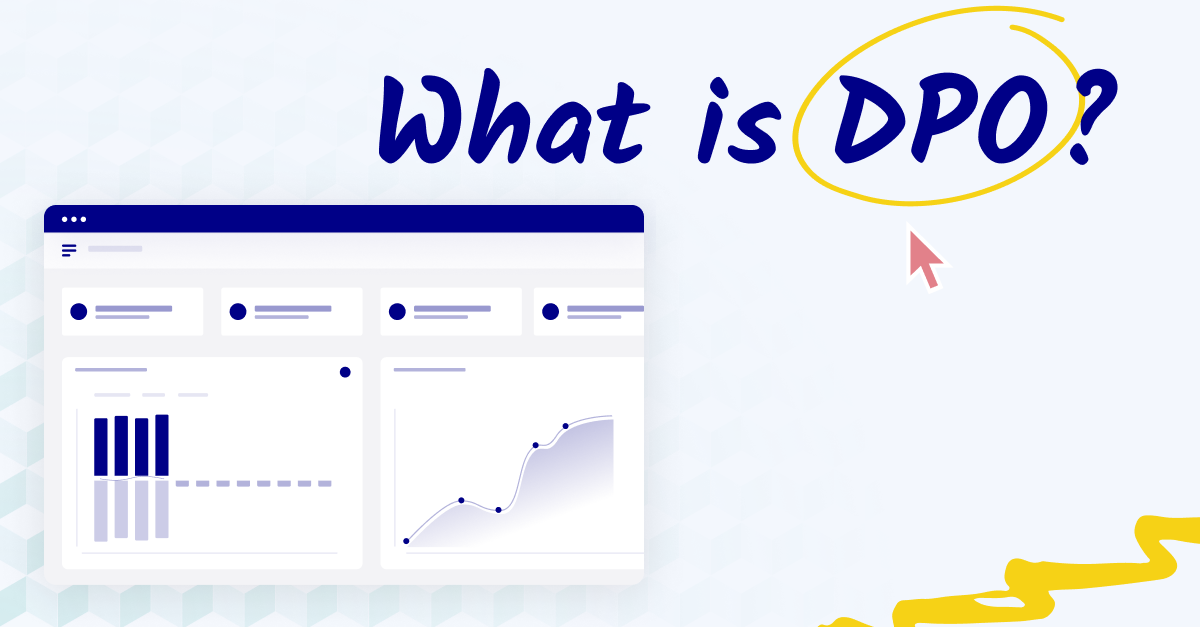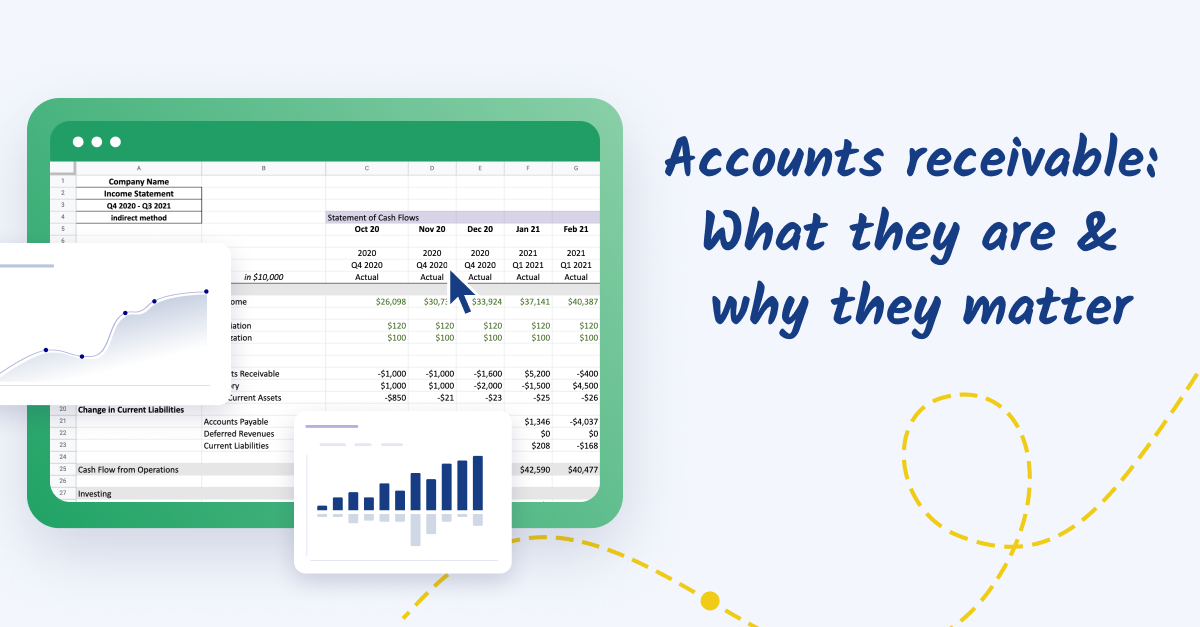What are the days payable outstanding and days sales outstanding metrics?
DPO and DRO are both activity metrics. Also called efficiency metrics, they show how well your company uses company resources on its balance sheet. Let’s start with a definition of the two metrics we’re talking about today:
Days Payable Outstanding (DPO)
This measures how many days (on average) a company takes to pay its suppliers. DPO provides a helpful view of cash liquidity, financial health, and other metrics like average inventory and annual revenue.
While DPO doesn’t provide a single reference for financial health, a reasonably high DPO shows that the company strikes a realistic balance between paying promptly and making good use of capital.
Companies typically measure DPO on a quarterly or annual basis.
Days Sales Outstanding (DSO)
This is a measurement of how many days it takes for a company to collect payments owed by its customers.
It is calculated by dividing the total amount of accounts receivable by the average daily sales for a certain period of time, usually one month.
Low DSO is a desirable metric, so long as you’re not rushing vendor payments at the expense of optimizing growth.
What's the difference between DPO vs. DSO?
DPO and DSO show two sides of the same coin when it comes to painting a picture of your cash inflows and outflows:
- DPO shows your cash going out to suppliers
- DSO shows your cash coming in from receivables
Is DSO the same as receivable days (DRO)?
Yes. DSO sometimes goes by the names Days billing outstanding (DBO) or Days Receivables outstanding (DRO).
Is DPO the same as days inventory outstanding (DIO)?
No, DSO and DIO are different metrics.
DSO represents how many days it takes for a company to collect payments owed by its customers.
Days Inventory Outstanding (DIO) measures the average number of days a company takes before replacing its inventory.
So they're different metrics, although DIO can affect sales cycles, which can then affect DSO.
What is the cash conversion cycle (CCC)?
The cash conversion cycle is the time it takes to turn a company's investments in inventory and other resources into cash from sales. It measures when a company pays for its inventory and collects payment from customers for that inventory.
This cycle includes three key components:
- The length of time it takes to purchase and receive inventory
- How long that merchandise stays in inventory before being sold
- How long it takes a customer to pay for the merchandise once they purchase it
The cash conversion cycle is one of the key financial indicators of your company’s operational efficiency.
What DSO and DPO say about accounts payable
High DPO is generally considered favorable, but like many metrics, it paints a clearer picture if you have some context.
However, it can also mean you take too long to pay creditors. Exceeding your payment terms with vendors may cause them to suspend service or place limits and fees on your accounts.
It could also mean you’re not fully utilizing your available credit terms (paying before items are due). While your vendors love being paid early, you may leave opportunities on the table by doing so. Keeping money in the bank longer provides more liquidity and flexibility.
The best DPO and DSO ratio balances meeting your obligations with maximizing your cash utilization.
Examples of healthy days payable outstanding and days sales outstanding numbers:
Your metrics for receivables and payables averages will vary based on your industry, but generally, the following guidelines apply:
-
A 45-day DSO means the company’s customers pay between 30 and 60 days after the invoice date. This combines healthy repayment terms and strong relationships with trustworthy, high-quality customers. For most companies, a 45-day DRO average is desirable.
How to calculate days payable outstanding and days sales outstanding
Here are the formulas used to calculate DPO and DSO. They can be calculated for any time period, but most often on a 365-day basis.
For calculating DPO:
- Take all of the company's accounts payable (found on the balance sheet).
- Divide it by the Cost of Goods Sold (COGS) plus any services that were bought on credit
- Multiply this by the number of days in a period (usually 365).
Note: COGS can be found under either “Cost of Sales” or “Cost of Goods Sold” on the income statement.
The days payable outstanding formula
DPO is super simple to calculate once you know the formula:
DPO = [Accounts Payable * Number of Days] ÷ Cost of Goods Sold (COGS)
For calculating DSO:
- Take all the company’s accounts receivable (found on the balance sheet).
- Divide this by the total credit sales since the start of the previous period.
- Multiply this by the number of days in a period (usually 365).
The result of these two numbers will give you two data points for evaluating the financial stability and liquidity of the company for the previous period.
Using these metrics in concert with other activity metrics (such as a quick ratio) helps paint a full picture of the data contained in financial statements for data-informed decision-making.

Why is a good DPO ratio important?
Keeping a healthy days payable outstanding (DPO) number is important to your financial planning.
Here are some of the benefits of maintaining a good DPO
A good DPO score means more than just better finances. It’s a window into your relationships with vendors, financial responsiveness, and overall reputation.
Stronger negotiation
New and existing suppliers see companies with a well-balanced DPO average as trustworthy and reliable. This can make it easier to negotiate good terms and secure discounts in the future (critical in the current economic climate).
Better supplier relationships
Vendors prioritize collaborative business relationships over transactional ones. This is reflected in consistent service for those that respect the relationship through timely payment.
Cost efficiency
Maintaining a continual balance between profitability and cash flow over time can help drive down long-term costs.
Access to funds
DPO metrics may be used in lending decisions or investment calculations. A strong DPO showing makes it easier for lenders to consider you for growth-supporting loans.
What if your DPO and DSO numbers aren’t strong?
If your DPO and DRO ratios aren’t where you want them to be, there are quite a few ways to improve them over time for better performance and outcomes:
Ways to improve DPO
Many elements of your days payable average are within your control. When looking to beef up this metric, consider one of the following methods:
Determine your current DPO
Before you make improvements in your DPO numbers, taking stock of where those numbers are currently is essential.
Using the formula above, calculate your average DPO based on your most recent balance sheet numbers.
Take time to find the average payment terms from your current suppliers. Ideally, your DPO should be a few days below the average repayment term across all suppliers.
Use your current DPO to set goals for changes to your days payable averages.
Slow your payment time
It should be obvious, but the quickest way to raise your DPO average is to pay slower — but still within your suppliers' net payment terms. Paying suppliers too quickly may seem to be the best action, especially if you have a strong cash position. But consider what you could do with that money by keeping it in-house.
If there’s room to extend your payments, there may be better ways to utilize the money while it’s still on your books.
Strategically time payments
Adjusting DPO is as much about when you pay and how long you take to pay. Paying invoices after the close of an accounting period increases the average accounts payable balance to decrease the DPO metric.
Negotiate better payment terms
If your low DPO results from short payment terms, work with your suppliers to gain some flexibility. Even if you’ve had difficulty with payments in the past, as your overall financial situation improves, suppliers may be more willing to extend credit terms.
If you’re paying quickly as a matter of efficiency, be sure your prompt payment is rewarded with early payment discounts or other advantages. Vendors are often willing to make speedy remittance worth your while.
Reduce COGS
Optimizing the cost of goods naturally changes the calculation for DPO, improving your average days. To improve your COGS, consider some streamlined methods:
- Leverage volume discounts: Buying in bulk from a supplier gives you access to better rates per unit. Find ways to consolidate your spending with a few preferred suppliers and improve your materials and production costs. Consolidating your vendor list reduces spending and saves processing costs by reducing the volume of invoices flowing through AP.
- Source cheaper materials: Use a competitive bid process to improve the pricing on inventory and materials for production. Reducing materials costs with less-expensive similars improves the overall cost of production. Look for opportunities to streamline costs without impacting quality.
- Reduce manufacturing labor: Labor often represents a large portion of COGS. Consider automation or off-shoring production costs to reduce the costs of production. Improving efficiency in your in-house production processes can also improve product margin.
Using any of these tips (or a combination of all) will increase your DPO, offering your company better flexibility to make the most of its available resources.
How to improve DRO
Unlike DPO, days receivable partially relies on external forces (customers paying their invoices). Despite this, there are a few ways to improve your DRO. Many of these mirror the tactics used to raise DPO averages.
- Tighten payment terms: If your vendor payment terms are net 60 or net 90, consider refining your payment window to a 30 or 45-day term. These shorter terms get payment in the door sooner. You may still reserve more flexible payment terms for long-term or top-tier customers who demonstrate a track record of quick payment.
- Offer early payment discounts: Incentivize your customers to quickly pay invoices: offer a small discount for early payment provides cash relief for your customer and reduces the outstanding invoices in your system. The benefit to your performance numbers may be worth the small reduction in revenue.
- Speed up invoice submission: If you want customers to pay invoices, they must arrive promptly. Submit invoices at the time of service to decrease the time to payment completion. Automating your accounts payable processing takes the burden off your AP clerks, ensuring timely and electronic delivery of invoices for faster customer repayment.
- Automate AR processes: As companies scale, the volume of accounts payable processing increases. Use technology to increase the processing speed for both AP and AR. The improved productivity in the department will translate to better DRO and DPO numbers.
- Consider factoring: Default accounts seriously impact your DRO numbers. Consider referring these accounts to a factoring company. While you’ll lose some percentage of the invoice value (10-15% on average), you’ll get the invoices off your books and improve your days receivable average.
Conclusion: track your cash conversion cycle in Cube
Centralized data makes it easy and efficient to track days payable outstanding, days sales outstanding, and every other metric that impacts your business. With fast calculations within Excel, your team can get a handle on the data and make data-informed decisions to drive the business forward.
Want to see Cube in action? Request a demo of the platform for more information.



.png)









